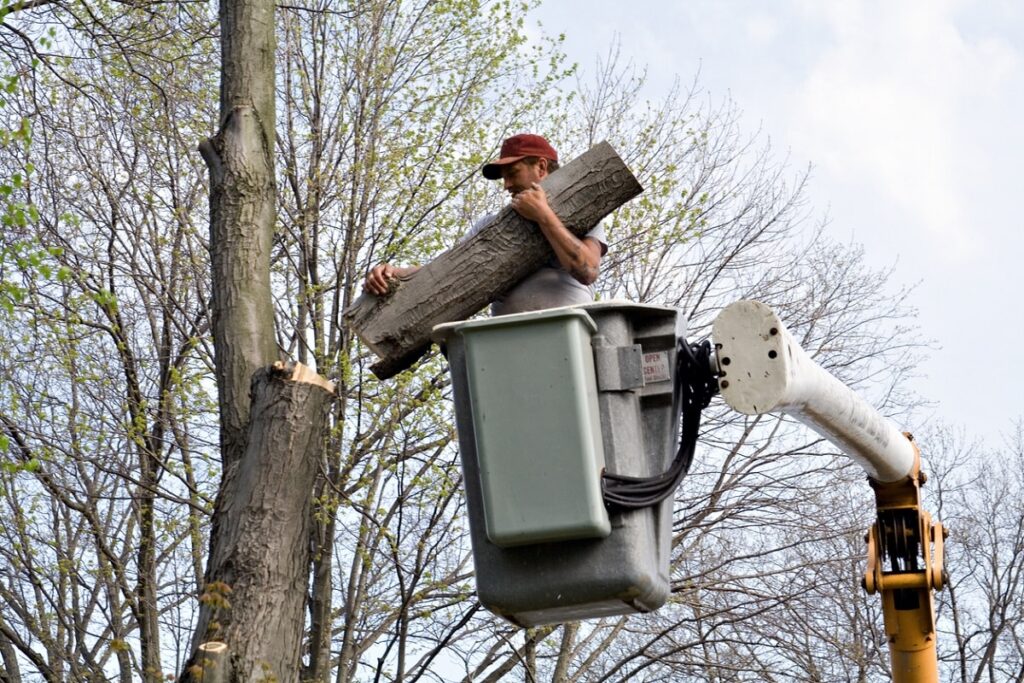Trees are the quiet guardians of our landscapes, standing tall, giving us shade, and adding a touch of woodland magic to our doorsteps. But sometimes, a tree can outstay its welcome or quietly turn into a hazard without us even noticing.
The trick is to spot the early signs of struggle before they cause bigger problems, and this article will show you how to do just that.
Signs to Look For
A tree doesn’t have to be on the verge of collapse for you to know that something is wrong. Long before that happens, it’ll send you subtle signals.
Deep cracks or rotten patches on the trunk are clear signs of distress. Leaves can also point to trouble. If they’re dropping early, changing colour too soon, or looking sparse when they should be lush, you need to take a closer look at your green companions.
Don’t forget to check what’s happening underground, too. Mushrooms or other fungi at the base often point to root decay, which can make even the sturdiest-looking tree unstable.
And if the trunk has started leaning in a way that doesn’t match its natural growth, take it as a warning sign rather than a quirk of character.
Safety Concerns
A charming tree in the wrong spot can be an accident waiting to happen. Branches stretching across rooftops or power lines might look picturesque from afar. But if a storm hits, you could find yourself dealing with snapped limbs, smashed tiles, or even blackouts.
The risks don’t necessarily dwindle when you’re closer to the ground, either.
Overhanging branches along paths and driveways could injure those passing by. And the last thing your poor delivery person needs when they’re balancing a tower of parcels is to be knocked cold by a stray limb!
If you notice branches dropping regularly, even if they’re small, this could point to deeper structural issues, too. A regular walkabout in your garden, with a keen eye on these risks, can save you a great deal of stress and money later on.
Impact on Property Value
As much as we love them, trees don’t always play nicely with houses. Roots can sneak beneath paving stones and foundations, causing cracks that cost a small fortune to repair.
Meanwhile, thick canopies might block sunlight, leaving your lawn patchy and your flowerbeds sulking in the shade.
There’s also the kerb appeal factor. A healthy, well-shaped tree can be the crown jewel of your garden, but a dying or badly placed one might drag the whole look down.
If you’re thinking of selling, it’s worth considering whether your struggling greenery is lowering your property’s value as well as its safety.
Pest Infestation
Sometimes, the problem isn’t the tree itself, but what has moved inside it. Tiny holes in the bark, oozing sap, or unusual marks can all indicate that pests have taken up residence in your beloved tree.
Woodpeckers tapping away are another surefire clue. Their incessant pecking usually means that they’re trying to reach insects hiding inside.
Some infestations are treatable, while others, like the dreaded ash dieback fungus, can be devastating. Before calling in the cavalry, there are a few simple remedies you can try.
A strong blast of water from the hose can dislodge aphids and mites, while diluted mild soap often deters soft-bodied pests lingering on leaves.
For scale insects, a gentle scrub with a soft brush and a little horticultural oil usually does the trick.
Home remedies can only go so far, though. Severe or persistent infestations usually require professional intervention.
This is where an arborist’s advice proves invaluable. They’ll know whether targeted treatments, pruning, or full removal is the better choice for your garden’s long-term health.
Environmental Considerations
Before you take drastic action, take a moment to think about the harmless creatures that call your tree home.
Birds, squirrels, and countless beneficial insects rely on the branches and bark for shelter and food. If you must remove a tree, you need to pick your timing carefully.
Avoid nesting season if you can. Late winter or very early spring is usually best, as that’s when most creatures are either hibernating or yet to settle in.
To soften their loss, consider planting a native replacement. That way, your garden will remain lively and supportive of local wildlife.
For instance, rowans will keep thrushes and blackbirds busy with their berries, while hawthorns offer dense cover for nesting birds and pollinators.
Cost of Removal vs. Repair
Professional tree removal isn’t cheap. However, repairing storm damage, cracked foundations, or a compromised roof can cost a lot more in the long run. When you look at it that way, you’ll see that it’s a worthy investment rather than an extra expense.
You can still save some money in the process, though. Getting quotes from a few reputable companies will give you a clearer picture and help you find the best deal.
Many even offer free assessments, so you don’t have to shell out your hard-earned cash just to find out where you stand.
That said, not every struggling tree needs to come down. With the right care, many can be saved. This is where tree surgery comes in.
From reshaping crowns to treating pests and improving soil conditions, qualified arborists can often give a struggling tree a new lease of life. And if removal really is the only option, they’ll guide you on the best time to do so to reduce the impact on local wildlife.
Permits and Legal Issues
In the UK, some trees are protected by preservation orders, and certain conservation areas have strict rules on what you can and can’t remove.
To stay on the right side of the law, check with your local council or planning authority before making any moves. This small step can save you hefty fines, disputes with neighbours, and the headache of undoing unauthorised work.
Once you’ve ticked the legal boxes, you can move forward with a clear conscience and focus on what’s best for your garden.
Conclusion
It’s not always easy to decide whether a tree has to go, but once you weigh up the risks and alternative options, the answer usually reveals itself.
With a little vigilance, some careful planning, and the right advice, you can confidently make the best choice for your garden.
If removal turns out to be the only route, you don’t have to see it as a loss—it’s actually a wonderful opportunity to welcome new life.
Who knows? You might even end up liking the newcomer more than the old giant.



